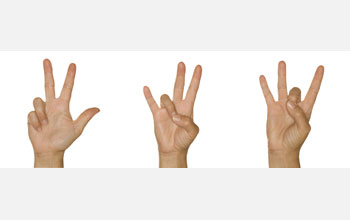All Images
News Release 11-026
Language May Play Important Role in Learning the Meanings of Numbers
Research shows "homesigners" unable to comprehend the value of large numbers
This material is available primarily for archival purposes. Telephone numbers or other contact information may be out of date; please see current contact information at media contacts.

Nicaraguan homesigners surrounded by hearing individuals who deal with large numbers all of the time do not have a complete understanding of numbers greater than three. Researchers conclude this is because they are not being taught numbers or number words. Here, American sign language for "three," "seven" and "eight" are shown.
Credit: © 2011 Jupiterimages Corporation
An example of a homesigner retelling a story in a number narrative task. The homesigner retells the following story: Ten sheep are in a pen, which the homesigner represents as nine (four fingers on his right hand, five on his left hand). Five of the sheep run out of the pen, which the homesigner represents as four fingers on his right hand, and five sheep remain in the pen, represented as five fingers on his left hand. One sheep is killed by a wolf, represented by onefinger on his right hand, and the other sheep represented first with four fingers and then three fingers on his right hand run back into the pen.
Credit: Courtesy of Elizabet Spaepen, University of Chicago
An example of a homesigner performing one of the non-communicative matching tasks, this time a cross-modal task. The homesigner has been instructed to make the number of chips she lays out equal to the number of knocks she feels. She places four chips for a target of six knocks, three chips for a target of three knocks, and three chips for a target of four knocks.
Credit: Courtesy of Elizabet Spaepen, University of Chicago


